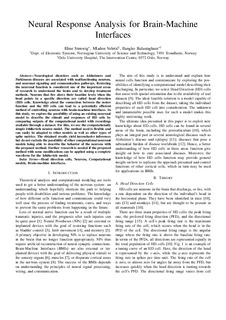| dc.contributor.author | Stenwig, Eline | |
| dc.contributor.author | Veletic, Mladen | |
| dc.contributor.author | Balasingham, Ilangko | |
| dc.date.accessioned | 2020-01-23T14:15:29Z | |
| dc.date.available | 2020-01-23T14:15:29Z | |
| dc.date.created | 2019-09-14T13:16:46Z | |
| dc.date.issued | 2019 | |
| dc.identifier.citation | International Symposium on Medical Information and Communication Technology. 2019, 2019-May:8743726 1-6. | nb_NO |
| dc.identifier.issn | 2326-828X | |
| dc.identifier.uri | http://hdl.handle.net/11250/2637703 | |
| dc.description.abstract | Neurological disorders such as Alzheimers and Parkinsons diseases are associated with malfunctioning neurons, and neuronal signaling and communication pathways. Restoring the neuronal function is considered one of the important areas of research to understand the brain and to develop treatment methods. Neurons that fire above their baseline levels when the head points in a specific direction are called head direction (HD) cells. Knowledge about the connection between the motor function and the HD cells can lead to a potentially efficient method of controlling neurons with brain-machine interfaces. In this study, we explore the possibility of using an existing neuronal model to describe the stimuli and responses of HD cells by comparing outputs of the computational model with recordings available through a dataset. For this, we use the computationally simple Izhikevich neuron model. The method used is flexible and can easily be adapted to other models as well as other types of spike metrics. The obtained results yield inconclusive inferences but do not exclude the possibility of other computational neuronal models being able to describe the behavior of the neurons with the proposed method. Further research is needed if the proposed method with some modifications can be applied using a complete waveform for the Izhikevich model. | nb_NO |
| dc.language.iso | eng | nb_NO |
| dc.publisher | Institute of Electrical and Electronics Engineers (IEEE) | nb_NO |
| dc.title | Neural response analysis for brain-machine interfaces | nb_NO |
| dc.type | Journal article | nb_NO |
| dc.type | Peer reviewed | nb_NO |
| dc.description.version | acceptedVersion | nb_NO |
| dc.source.pagenumber | 1-6 | nb_NO |
| dc.source.volume | 2019-May:8743726 | nb_NO |
| dc.source.journal | International Symposium on Medical Information and Communication Technology | nb_NO |
| dc.identifier.doi | 10.1109/ISMICT.2019.8743726 | |
| dc.identifier.cristin | 1724684 | |
| dc.description.localcode | © 2019 IEEE. Personal use of this material is permitted. Permission from IEEE must be obtained for all other uses, in any current or future media, including reprinting/republishing this material for advertising or promotional purposes, creating new collective works, for resale or redistribution to servers or lists, or reuse of any copyrighted component of this work in other works. | nb_NO |
| cristin.unitcode | 194,65,25,0 | |
| cristin.unitcode | 194,63,35,0 | |
| cristin.unitname | Institutt for sirkulasjon og bildediagnostikk | |
| cristin.unitname | Institutt for elektroniske systemer | |
| cristin.ispublished | true | |
| cristin.fulltext | postprint | |
| cristin.qualitycode | 1 | |
